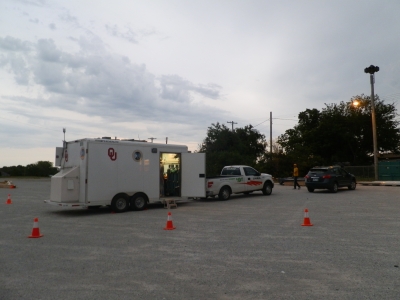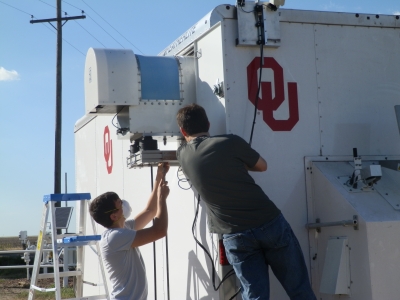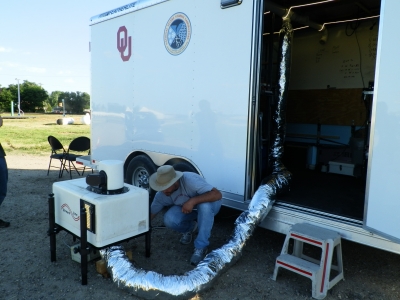Mission Ready
Published: 21 July 2015
Editor’s Note: Ben Toms, intern from University of Oklahoma for the Plains Elevated Convection at Night (PECAN) field campaign, sent this update.
The past few weeks have been adventurous for the PECAN-CLAMPS team, with a burst of meteorological conditions favorable for nocturnal convection. As of June 27, there had been 14 intensive observational periods which means about 1 out of every 2 days has been devoted to a mission. That was a lot of missions considering the extended periods of driving the team has to do to reach their deployment locations. For example, the CLAMPS, or Collaborative Lower Atmosphere Mobile Profiling System, team drove over 700 miles in one 24-hour period! That doesn’t even count the time spent sampling the atmosphere.
Phew. It’s all worth it, though, as we’ve been able to experience some truly fantastic meteorological events first-hand and gather data that have never been collected before.

Ready…set…deploy!
Before I divulge the details of a few of our missions over the past weeks (we’ll get to that in the next blog post), I thought I’d touch on deployment strategies of CLAMPS. The instruments within the CLAMPS trailer itself are worth over a million dollars, so ensuring the trailer is as safe as possible at all times is of utmost importance to the group. This means the truck hitched to the trailer has to slow down on highways and interstates. Could you imagine a million bucks just flying off the road? No thanks!
Because of this, the team members on deployment split up into two teams—half in the truck, half in the “scout” vehicle. The scout vehicle then drives ahead of the truck and determines a location that the scout team members deem both safe for deployment and optimal for data collection (i.e., no large obstructive buildings that could block a laser beam). Once the team leader (which varies on an approximately weekly basis to give team members a break) checks the designated deployment location and gives it the okay, and the deployment process begins.
The locals tend to be rather interested in what the CLAMPS trailer is all about (understandably so!), so the team initially sets a perimeter of warning cones to protect the team from potential traffic. Then, the atmospheric emitted radiance interferometer (say that 10-times fast!), microwave radiometer, and lidar devices are deployed—typically all at the same time. Activities within the trailer can get pretty chaotic with multiple people trying to set up instruments, so half the team takes to assisting with trailer-exterior deployment. This efficient process leads to a typical set-up time of approximately 15 minutes, well under the initially established 30 minute allotted time period. The first weather balloon is launched nearly immediately following deployment.

What if…
Sometimes, the instruments malfunction and the team has to quickly adapt. As ARM campaign principal investigator (PI) Dave Turner has coined, ‘this truly is a maiden voyage if there ever has been one.’ We haven’t been without challenges. A few errors within the construction of the trailer inherently have occurred, but the team has been very quick to adapt.
Let me paint a quick picture: two small leaks in the trailer ceiling were discovered with the assistance of a fairly intense thunderstorm. This didn’t bode well given the amount of electronic equipment within the trailer (remember how I mentioned how expensive the instruments are!), so the team had to manually deploy the lidar outside of the trailer until the lift table was fixed and operational. The lidar weighs over 150 pounds, not a small load—especially when the lidar is covered in water!

Further complications arose when summer decided to make its arrival over the past week and temperatures soared to the near 100s during the afternoon hours. This led to the lidar intermittently overheating. To combat the heat, the team developed the iconic “Super Cool Tube.” This tube was attached to the in-trailer air conditioning system, funneling cold air directly onto the lidar, in a successful attempt to keep it below overheating-temperature thresholds.
Crisis averted
Once we’ve put out the fires so-to-speak, and the team is deployed, operations continue until 3 to 6 a.m. depending on the mission type. The team periodically launches weather balloons during the deployment period and ensures the instruments are working as desired. We also send data visualizations back to the operations center so the scientists stationed back in Hays can also get a peek at what the atmosphere looks like beyond numerical weather prediction model output.
The PECAN project is wrapping up in the coming days, so we’ll have a better idea of the outcomes of the project once we sit back and consider all we’ve accomplished. The entirety of teams out here have pushed themselves really hard to gather the best data we can, so everybody is very excited to start sifting through it all!
The ARM Climate Research Facility is a DOE Office of Science user facility. The ARM Facility is operated by nine DOE national laboratories, including .
Keep up with the Atmospheric Observer
Updates on ARM news, events, and opportunities delivered to your inbox
ARM User Profile
ARM welcomes users from all institutions and nations. A free ARM user account is needed to access ARM data.


















